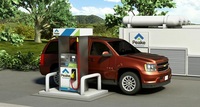New "CNG In A Box" Fueling System Makes U.S. Debut Says NACS
NACS retailers will get the first glimpse at a new compressed natural gas system available for convenience stores. October 8
LAS VEGAS October 8, 2012; The NACS newsletter reported that convience store retailers will get their first glimpse today at the NACS Show expo of a new CNG retailing system that will allow them to offer CNG at their stores through simple “plug-and-play” equipment and traditional-looking Wayne dispensers, complete with hoses and credit card reader.
The “CNG In A Box” system is being unveiled by General Electric (GE) in partnership with Chesapeake Energy Corp. and should give marketers easy access to the growing CNG light vehicle market — passenger cars, pickups, vans, SUVs and taxicabs, as well as buses, garbage and delivery trucks. NACS Show attendees can catch a glimpse of the system in action in booth 6101.
However, retailers who sell gasoline as a loss leader at their stores will need to rethink their marketing strategy when it comes to CNG, says Kent Wilkinson, a top executive with Peake Fuel Solutions, an affiliate of Chesapeake that is helping bring GE’s CNG tech to market.
”In many operations today, a marketer’s retail price is a commodity price and a small portion of his capital costs and he makes his money from in-store sales,” says Wilkinson. “With CNG, it’s the other way around — it’s a high-margin product that you can use to drive people to your store,” he told NACS Daily.
Marketers who have hesitated to embrace alternative fuels may find the CNG box concept greatly improves their comfort level. There’s no need for complex spec sheets because almost everything needed is included in the 8.5 ft. by 8.5ft by 20 ft. long box, including the compressor and gas cooler. Only two pieces are shipped separately, the Wayne dispenser and the motor control center.
Of course, marketers will need access to a natural gas line, the kind that runs into millions of U.S. homes, in order to retail CNG.
Pricewise, the wholesale cost of natural gas runs about 40 cents per-gasoline-gallon-equivalent (gge) and commands a retail price of around $2.09/gge, providing a $1.69 gross margin for utility and operating costs and capital recovery. Retailers will often conclude that 15,000 gge/month is sufficient demand to initiate investment, Wilkinson notes.
The market for CNG has been growing steadily, especially with gasoline prices on the increase. Ford, General Motors and Chrysler are all coming out with light-duty pick-up trucks and overall production is expected to be around 4,000-plus vehicles a year per OEM.
Currently, there are approximately 1,100 CNG fueling locations in the U.S. serving a total 125,000 to 150,000 vehicles. In a light-duty pick-up market, a customer base of 150 to 200 vehicles would be enough to pay off your investment in terms of cash flow, he says.
Obviously cost is a major factor and it will vary, depending on how fancy the marketer wants to get. Generally, a CNG in A Box system will run from $700,000 to $1.2 million, depending, for example, on the dispenser options chosen, or whether a marketer wants a canopy. Local jurisdiction requirements for spacing and public amenities, site conditions, and whether it will be an attended or unattended operation also play a part.
Peake is currently installing the equipment at two ground-up sites in Marshall and Cleburne, Texas, and has found that individual conditions can create a 40%-plus spread in installed costs, which is why Peake will work with customers to develop solutions to meet their particular needs, Wilkinson added.
GE Capital is offering a financing program for qualified marketers, and is looking at a rate of 2.9% over a fixed 48-month term. Delivery, installation and maintenance can be combined into a single monthly payment, eliminating the cost and time associated with multiple vendors, Peake says. Payments also can be structured according to cash flow, with options such as deferred and stepped payments.
“The unit is competitively priced and based on our confidential research, provides as much as 60% more throughput than other similarly priced units,” Wilkinson said.
“We’re comfortable with the market, it’s not a brand new market,” he notes. “There are people out there with lower-volume CNG units that dispense 1.5 to 2.5 gge/ minute. Peake’s system pumps up to 7.5 gge/minute and can handle up to 10,000 gge/day, which means there will be no need to replace it any time soon.
As for marketing, retailers can take any number of approaches.
A major selling point for fleets and consumers will be price, efficiency and the smaller environmental footprint of CNG.
A vehicle using CNG can reduce annual fuel costs by up to 40%, assuming 25,700 miles per year driven, gasoline priced at $3.50 and CNG at $2.09/gge, which Peake says represents savings of about $1,500 per fleet per vehicle.
Marketers can also show that they are part of a “green solution” to the country’s energy issues. For each fleet vehicle using fuel from CNG In a Box instead of gasoline, an operator can reduce CO2 emissions from fuel combustion by about 24%, or 2.2 metric tons per vehicle a year, assuming 25,700 miles a year travelled.
Under their agreement, starting this fall GE will supply more than 250 of the standardized modular units as part of an effort to help develop CNG infrastructure. The two companies also are eyeing the natural gas home heating market.



